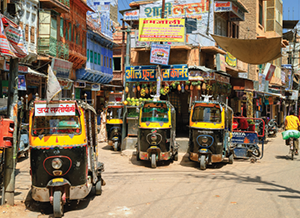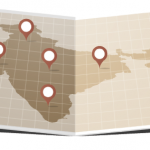
Auto rickshaws, also known as tuk-tuk, waiting for passengers in a daily market. Tuk-tuk is the most popular transport vehicle in India.
Boris Stroujko/shutterstock.com
In the good old days, physicians routinely made house calls. The decision to visit the literal bedside of a patient was practical: hospital services were primitive and often offered too little benefit to justify an emergency journey by the patient. These physicians carried leather bags, sometimes called Gladstones, that were filled with instruments for eventualities that could include delivering a baby to amputating a limb that had been grievously crushed or infected. An ampoule of morphine was a prized therapeutic and, undoubtedly, more effective than some of the herbs and poultices that then constituted medical therapy.
Times have changed. A physician making a house call in the U.S. is a rare sight indeed—except perhaps for people with special concierge plans. Instead of visiting homes in the city or countryside, physicians now visit countries. Replacing the venerable black bags, today’s physicians carry freezer chests packed with vaccines and antibiotics and cargo boxes filled with textbooks and medical equipment.
In another important trend, universities and medical schools have created institutes and centers to address healthcare from a worldwide perspective. These global health programs, which are attracting some of the best and brightest young minds, have been game-changers and have led to extraordinary advances in clinical care and research.
Act Locally
Despite recognition of the gigantic healthcare problems overseas, many in the medical profession, as in many other fields, have embraced the concept of “Think globally; act locally” as their guiding principle.
I, for one, have been both a local thinker and local actor and have practiced in the same exact place in Durham, N.C., for almost 39 years. The needs in medicine are always great, and caring for patients anywhere is one of life’s highest and most rewarding callings. In medicine, good deeds do not require long journeys.
My own awakening interest in this area began with the Bone and Joint Decade (BJD). The BJD was a worldwide initiative from 2000–2010 that had the formal recognition of many governments and the World Health Organization, all committed to reducing the burden of musculoskeletal disease. At the end of the decade, in 2009, the organization held a meeting in Washington, D.C., to review its activities and commemorate its accomplishments.
The BJD meeting was a revelation.
At the meeting, I learned that the developing world has an enormous problem with musculoskeletal disease that makes this group of illnesses a major source of disability and diminished quality of life. The causes, however, are very different from those of the West. Indeed, in the poorer countries, damage to bones and joints occurs not from inflammation or degeneration but from trauma, with road injury from vehicular accidents a leading cause.
Heterogeneous Traffic
The World Health Organization estimates that 1.3 million people in the world die on the road each year and that the number could increase to 1.9 million by 2020. Further, as highlighted in studies on the global burden of disease published in the journal Lancet, road accidents not only kill, but they maim. Each year, 50 million people worldwide are seriously injured by road accidents.
